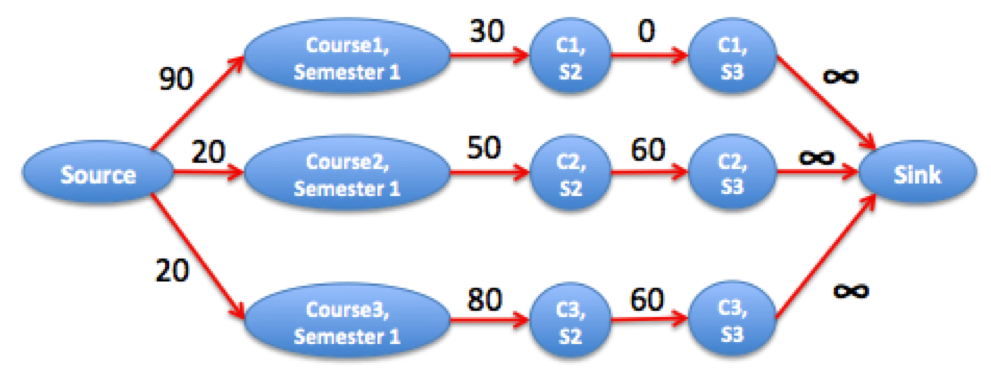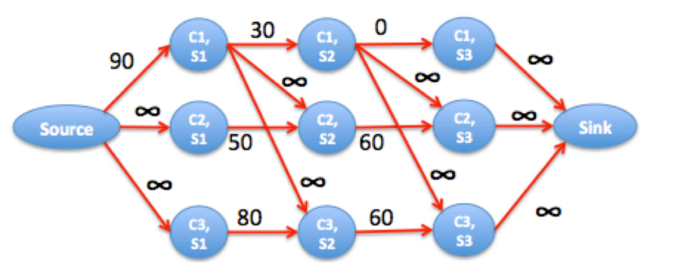Course Selection CodeChef - RIN
All submissions for this problem are available.
Read problems statements in Mandarin Chineseand Russian.
Rin is attending a university.
She has M semesters to finish her program, and that program has N required courses. Each course must be taken in exactly one of the semesters.
Some courses have prerequisites: for each i from 1 to K, she must take course A[i]before course B[i].
The same course may be taught by different professors in different semesters, and how well she does will depend on which professor teaches her. Additionally, some courses may not be taught every semester.
We are given an array X representing this information. For each course i and each semester j, X[i][j] = -1 if course i is not taught in semester j. Otherwise, X[i][j] will be an integer between 0 and 100: the expected score Rin will get if she takes course i in semester j.
Rin may take any number of courses per semester, including none, as long as they are taught that semester and she has already taken any required prerequisite courses.
Help Rin to find the maximal average score she can get over her whole program.
Input
The first line contain 3 integers: N, M and K.
This is followed by N lines, each containing M integers. The jth integer on the ith line represents the value of X[i][j].
This is followed by K lines, each containing two integers: A[i] and B[i].
Output
Output one real number: the maximal average score, rounded to 2 digits after the decimal point.
Constraints
- 1 ≤ M, N ≤ 100
- 0 ≤ K ≤ 100
- -1 ≤ X[i][j] ≤ 100
- 1 ≤ A[i], B[i] ≤ N
- For each i, A[i] ≠ B[i].
- For different i and j, (A[i], B[i]) ≠ (A[j], B[j]).
- We guarantee there exists a way to take these N courses in M semesters.
Subtasks
Subtask 1: (20 Points) A course can have at most 1 pre request course.
Subtask 2: (80 Points) Refer to constraints above
Example
Input 1:
3 2 2
70 100
100 80
100 90
1 2
1 3 Output 1:
80.00 Input 2:
4 5 4
20 -1 100 -1 -1
100 30 -1 -1 -1
100 -1 30 20 40
100 30 40 50 20
1 2
1 3
2 4
3 4 Output 2:
32.50
Explanation
Example case 1
The only way she can finish these 3 courses is: take course 1 in the first semester, then take courses 2 and 3 in the second semester. The average score is (70 + 80 + 90) / 3 = 80.00.
Example case 2
The optimal solution is: take course 1 in semester 1, course 2 in semester 2, course 3 in semester 3 and course 4 in semester 4.
EXPLANATION:
First, let's ignore the dependencies. The answer is just the maximum grade per course in any of the semesters, which is trivial to compute but let's put this in another perspective:
For each course, the best grade is 100 - (minimum grade we lose by picking one of the semesters).
To model this as a network flow graph, we do 4 things:
- Create a vertex for each pair (course i, semester j).
- Create a source vertex which is connected to the first semester of each course i by an edge with capacity 100 - grade(i, 1).
- For every semester j from 2 to M, connect the vertices of each course i from semester j-1 to j with capacity 100 - grade(i, j) or 100 if the course is not available (it's the same as having grade 0, recall that it's guaranteed there is a solution).
- Create a sink vertex and connect the last semester of each course to it, with infinite capacity.
Consider the following example with 3 courses and 3 semesters:
3 3
10 70 100
80 50 40
80 20 40

The corresponding graph is depicted in the above picture. The maximum flow is equal to the combined grade loss for all courses. We pick semester 3 for course 1 (zero loss), and semester 1 for courses 2 and 3 (loss 20+20). The maximum grade average we can get is (N * 100 - maxflow) / N. In this case: (3*100 - 40) / 3 ~= 86.67.
- Returning to the problem, why does this help?
If we model the problem this way, we can also include the course dependencies. Suppose there are dependencies 1->2 and 1->3. The best we can do is course 1 in semester 2 and courses 2 and 3 in semester 3 for (70+40+40)/3 average.
- If there are dependencies 1->2 and 1->3, then courses 2 and 3 can never be done in the first semester.
This implies that the minimum grade loss for courses 2 and 3 is not bounded by its grades in semester 1. This is the same as changing the capacities associated to semester 1 of courses 2 and 3 to infinity.
- Why do we pick semester j for course 1?
The combined grade loss of doing course 1 in semester 2 + courses 2 and 3 in semester 3 is less than doing course 1 in semester 1 + courses 2 and 3 in semesters 2 or 3.
In terms of network flow, this means that
- if we pick semester j = 1, then courses 2 and 3 are not bounded by grade loss in semester 1. To combine the grade loss by picking semester 1, we connect vertex (course 1, semester 1) to (course 2, semester 2) and (course 3, semester 2) with infinite capacity.
- if we pick semester j = 2, then courses 2 and 3 are not bounded by grade loss in semesters 1 and 2. Same as above but connecting (course 1, semester 2) to courses 2 and 3, semester 3.
- picking semester j = 3 is not possible.
The resulting network is the following

We can see that the maximum flow is 150. The best is to distribute the grade loss of course 1 in semester 2, flow 3, among courses 2 and 3 in semester 3. In fact, 70+40+40 = 300 - 150.
To give you another example, consider the input
3 3 2
10 50 100
80 90 40
80 40 70
1 2
1 3
The best we can do course 1 at semester 1 (10) + course 2 at semester 2 (90) and course 3 at semester 3 (70) = 10+90+70. The resulting graph is

We can see that the maximum flow is 130 because in this case, it is better to distribute the grade loss of course 1 at semester 1, the flow 90, among the grade loss of courses 2 and 3 over semesters 2 and 3, respectively.
In a nutshell, we create a graph with N*M+2 vertices and use a standard maximum flow algorithm. The hard part was to realize how to build the network correctly.
Proof sketch:
Since max-flow equals min-cut, we can think of our problem as of finding a minimum cut in the above graph. Let Pi be a path corresponding to i-th course, i.e. the path formed of edges corresponding to i-th course in all semesters. In order to prove the correction of the above construction, we can show two properties of the graph:
- For every 1 <= i <= N, min-cut contains exactly one edge from Pi.
- For every constraint (i, j), if min-cut contains the k-th edge of Pi, then it contains the x-th edge of Pj, where x > k i.e. j-th course is taken in later semester than i-th course.
These two fact can be shown quite easily, but we will omit exact proofs here. Intuitively, if you pick any edge from Pi, then Pi is disconnected and there is no need for taking any other edge from it. Moreover, an edge (i, j) corresponding to a constraint, prevent us of taking course j before course i, because if you did it, then in order to make the graph disconnected, you would have to add the second edge of Pj to min-cut which contradicts the first fact.
#include<cstdio>
#include<cstring>
#include<iostream>
#define inf 2e9
using namespace std;
const int Z=101;
const int N=Z*Z;
const int M=2e6+5;
struct edge{int v,next,cap;}e[M];int tot=1,head[N];
int n,m,k,cnt,ans,S,T,id[Z][Z],X[Z][Z],dis[N],q[M];
inline int read(){
int x=0,f=1;char ch=getchar();
while(ch<'0'||ch>'9'){if(ch=='-')f=-1;ch=getchar();}
while(ch>='0'&&ch<='9'){x=x*10+ch-'0';ch=getchar();}
return x*f;
}
inline void add(int x,int y,int z){
e[++tot].v=y;e[tot].cap=z;e[tot].next=head[x];head[x]=tot;
e[++tot].v=x;e[tot].cap=0;e[tot].next=head[y];head[y]=tot;
}
inline bool bfs(){
for(int i=S;i<=T;i++) dis[i]=-1;
int h=0,t=1;q[t]=S;dis[S]=0;
while(h!=t){
int x=q[++h];
for(int i=head[x];i;i=e[i].next){
if(e[i].cap&&dis[e[i].v]==-1){
dis[e[i].v]=dis[x]+1;
if(e[i].v==T) return 1;
q[++t]=e[i].v;
}
}
}
return 0;
}
int dfs(int x,int f){
if(x==T) return f;
int used=0,t;
for(int i=head[x];i;i=e[i].next){
if(e[i].cap&&dis[e[i].v]==dis[x]+1){
t=dfs(e[i].v,min(e[i].cap,f));
e[i].cap-=t;e[i^1].cap+=t;
used+=t;f-=t;
if(!f) return used;
}
}
if(!used) dis[x]=-1;
return used;
}
inline void dinic(){
while(bfs()) ans-=dfs(S,inf);
}
inline int getY(int x){
if(~x) return 100-x;
return inf;
}
int main(){
n=read();m=read();k=read();
for(int i=1;i<=n;i++){
for(int j=1;j<=m;j++){
X[i][j]=read();
}
}
for(int i=1;i<=n;i++){
for(int j=1;j<=m;j++){
id[i][j]=++cnt;
}
}
S=0,T=n*m+1;
for(int i=1;i<=n;i++){
add(S,id[i][1],getY(X[i][1]));
for(int j=2;j<=m;j++) add(id[i][j-1],id[i][j],getY(X[i][j]));
add(id[i][m],T,inf);
}
for(int i=1,a,b;i<=k;i++){
a=read();b=read();
add(S,id[b][1],inf);
for(int j=2;j<=m;j++) add(id[a][j-1],id[b][j],inf);
}
ans=100*n;
dinic();
printf("%.2lf",1.0*ans/n);
return 0;
}Course Selection CodeChef - RIN的更多相关文章
- CodeChef - RIN Course Selection
Read problems statements in Mandarin Chineseand Russian. Rin is attending a university. She has M se ...
- Codechef RIN 「Codechef14DEC」Course Selection 最小割离散变量模型
问题描述 提供中文版本好评,一直以为 Rin 是题目名字... pdf submit 题解 参考了 东营市胜利第一中学姜志豪 的<网络流的一些建模方法>(2016年信息学奥林匹克中国国家队 ...
- [CODECHEF]RIN
题意:一个人要在$m$个学期上$n$节课,在第$j$学期上$i$课有$X_{i,j}$的收益,有些课$B_i$有前置课程$A_i$,问最大得分 这个题我都做不出来还去看题解...我退役吧== 考虑每种 ...
- CodeChef - RIN 最小割应用 规划问题
题意:给定\(n\)门课和\(m\)个学期,每门课在每个学期有不同的得分,需要选定一个学期去完成,但存在约束条件,共有\(k\)对课程需要\(a\)在\(b\)开始学前学会,求最大得分(原问题是求最高 ...
- [CodeChef]RIN(最小割)
Description 有m门课可以在n个学期内学习,第i门课在第j个学期的收益是\(X_{i,j}\),一个学期可以学多门课,有的课之间有依赖关系,即必须先学a再学b,求最大收益.n,m<= ...
- Codechef Course Selection
Home » Practice(Hard) » Course Selection Course Selection Problem Code: RINSubmit https://www.codech ...
- codechef营养题 第三弹
第三弾が始まる! codechef problems 第三弹 一.Motorbike Racing 题面 It's time for the annual exciting Motorbike Rac ...
- codechef营养题 第二弹
第二弾が始まる! codechef problems 第二弹 一.Backup Functions 题面 One unavoidable problem with running a restaura ...
- codechef 营养题 第一弹
第一弾が始まる! 定期更新しない! 来源:http://wenku.baidu.com/link?url=XOJLwfgMsZp_9nhAK15591XFRgZl7f7_x7wtZ5_3T2peHh5 ...
随机推荐
- [转]sql:除非另外还指定了 TOP 或 FOR XML,否则,ORDER BY 子句在视图、内联函数、派生表、子查询
执行sql语句: select * from ( select * from tab where ID>20 order by userID desc ) as a order by date ...
- python3的pip管理器pip3
一且因为python2到3的痛苦升级,python3的pip程序也有一个别致的名字pip3 安装: apt-get install python3-pip 安装后不能直接使用pip,否则会提示没有安装 ...
- 李洪强iOS经典面试题36-简单介绍 ARC 以及 ARC 实现的原理
李洪强iOS经典面试题36-简单介绍 ARC 以及 ARC 实现的原理 问题 简单介绍 ARC 以及 ARC 实现的原理. 考查点 ARC 是苹果在 WWDC 2011 提出来的技术,因此很多新入 ...
- 使用【单独】的一个<script>进行js文件的引用
刚才用jQuery的时候,总是发现js代码不被执行...后来发现我的代码是这么写的: <script type="text/javascript" src="htt ...
- 在编写JSP的时候出现XXX cannot be resolved to a type
今天遇到这个情况,却发现是eclipse抽风,说javax.servlet.http.Cookie找不到定义,但是经过浏览器测试,可以运行,而JSP源文件中eclipse死活要报错.表示无语. 关于e ...
- service文件(格林速洗项目)
service文件模板:String url="http://59.78.93.208:9097/Order?id="+id+"&value="+val ...
- MapReduce原理<转>
江湖传说永流传:谷歌技术有"三宝",GFS.MapReduce和大表(BigTable)! 谷歌在03到06年间连续发表了三篇很有影响力的文章,分别是03年SOSP的GFS,04年 ...
- 16c554 的头文件
//------------------------------------------------------------------------------ #ifndef AT16C554H # ...
- linux 安装开启SNMP协议,最下面是yum安装
Linux SNMP 以下的示例采用SUSE10 Linux环境,但它同样适用于其它Linux发行版. 编译和安装 首先我们需要下载Net-SNMP的源代码,选择一个版本,比如5.7.1,地址如下: ...
- 为什么逻辑斯特回归(logistic regression)是线性模型
一个典型的logistic regression模型是: 这里明明用了非线性函数,那为什么logistic regression还是线性模型呢? 首先,这个函数不是f(y,x)=0的函数,判断一个模型 ...
